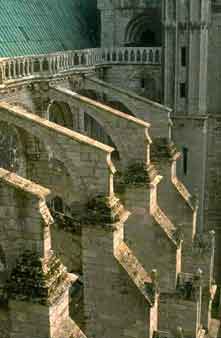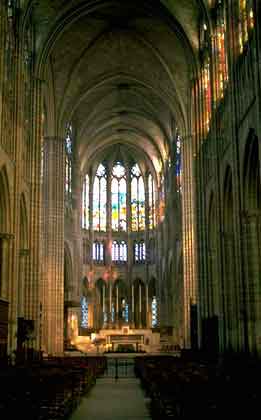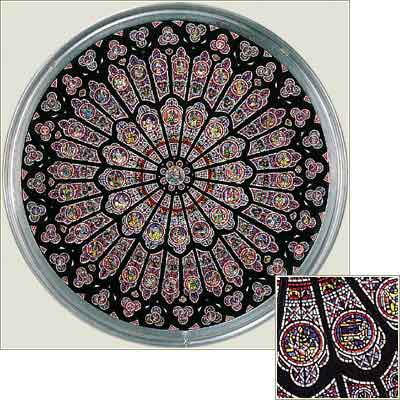CHURCHES: MIDDLE AGES
In western Europe, which divided into various small,
Christian kingdoms after the Roman Empire collapsed in the west, this tradition
of imbuing Christian sanctuaries with a sense of divine closeness continued and
blossomed in the Middle Ages. Churches conveyed that central paradox of
Christian tradition: the profound connection between a transcendent god
and the human plain of existence. Jesus Christ had accomplished the total
connection of divine and human through the incarnation; church architecture
sought to emulate, invoke, and even reproduce the mystery of that divine-human
connection.
The pinnacle of this divine architecture was the Gothic
architecture of the "high" Middle Ages (approximately 1200-1400).
The
term "gothic" was applied much later by art historians who misunderstood the
stark and angular nature of these massive structures and attributed it to the
barbarians of the sixth century. For medieval Christians, these were deeply and mysteriously "houses of
God."
The key architectural innovation that allowed the massive
structures to rise higher even than Justinian's Hagia Sophia was the "flying
buttress":
 These
structural supports, attached to the exterior of the church, allowed the weight
of thousands of tons of stone and roof to be distributed much more evenly, and
supported by the solid ground. Once the walls were freed of the burden of
supporting the weight of the whole building, they could be filled with the
delicate and multicolored stained glass that became the hallmark of the Gothic
cathedral.
These
structural supports, attached to the exterior of the church, allowed the weight
of thousands of tons of stone and roof to be distributed much more evenly, and
supported by the solid ground. Once the walls were freed of the burden of
supporting the weight of the whole building, they could be filled with the
delicate and multicolored stained glass that became the hallmark of the Gothic
cathedral.
Imagine walking into a church in the days before
electricity and bright interior lighting, to find a space filled with colors:


(right: interior of Notre Dame de Paris; left,
southern rose window of Notre Dame)
The windows were filled with images taken from the Bible,
the lives of the saints, the lives of the Christian community. Like the
shafts of light in the Hagia Sophia, the brilliant colors of the Gothic
cathedral created a sense of oneness with a transcendent God. The starkly
vertical interior likewise drew the eyes and mind upwards: the cathedral
itself, shooting upwards from humanity to the heavens, was a miniature replica
of the Christian universe.
continue the slide show
 These
structural supports, attached to the exterior of the church, allowed the weight
of thousands of tons of stone and roof to be distributed much more evenly, and
supported by the solid ground. Once the walls were freed of the burden of
supporting the weight of the whole building, they could be filled with the
delicate and multicolored stained glass that became the hallmark of the Gothic
cathedral.
These
structural supports, attached to the exterior of the church, allowed the weight
of thousands of tons of stone and roof to be distributed much more evenly, and
supported by the solid ground. Once the walls were freed of the burden of
supporting the weight of the whole building, they could be filled with the
delicate and multicolored stained glass that became the hallmark of the Gothic
cathedral.
